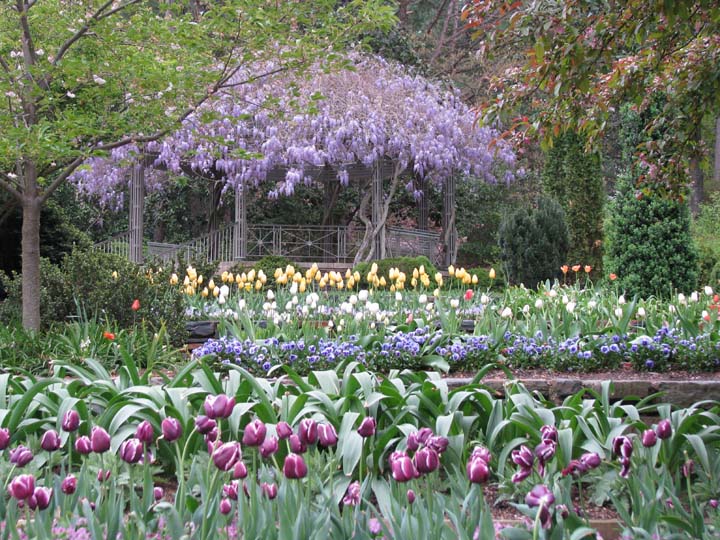Content

Sarah P. Duke Gardens, Duke University, Durham, North Carolina
In the early 1930s, Dr. Frederic M. Hanes, a pathologist, neurologist and chair of the Department of Medicine at Duke University, saw promise in a debris-filled and overgrown ravine that he passed as he walked to work each day. In 1934, Hanes – who was in many ways the first director of development for Duke Gardens – convinced Sarah P. Duke that his dream of an iris garden only needed her generosity to be realized. Where the South Lawn is today, they created the first Sarah P. Duke Garden full of beds of annuals, bulbs, and irises. Sadly, the heavy summer rains of 1935 did so much damage to the plantings that Hanes realized he needed a new plan.
Sarah P. Duke died in September 1936, but Hanes persuaded her daughter, Mary Duke Biddle, to fund a new, more formal garden in memory of her mother. The second plan brought Ellen Biddle Shipman into the history of the Gardens.
Shipman, a well-known landscape designer and one of the first women to be successful in that field, designed the Italianate-style Terraces to take advantage of the natural slope of the land. Her inspiration was the globe of the earth, with the seven curved terraces of dry stacked Duke Stone representing lines of latitude.
It helps to remember that when the Terraces were built, the entrance to the Gardens was from Flowers Drive. Visitors would have seen the Terraces as a whole, with the Pergola topping off the vista. You can recapture the impact of Shipman’s design by walking up to the Rock Garden and looking back.
The Terraces were dedicated on Friday, April 21, 1939. Under the Pergola is a plaque with these words: Sarah P. Duke Gardens given by Mary Duke Biddle In memory of her mother in whose life were blended the strength of the soil and the beauty of flowers.
In 1959, the university’s trustees set aside 55 acres for the Gardens. Director Paul J. Kramer and Superintendent (and eventual Director) Richard Fillmore saw the need for a master plan to direct the development of the Gardens. They engaged William B.S. Leong, a landscape architect and Boston city planner, to design the first of several master plans that have shaped the Gardens.
So many people have lent their talent, vision, hard work, and support to expand the Gardens. Dr. H.L. Blomquist’s love for the flora of the Southeastern United States is carried on in the Garden of Native Plants that bears his name. As Director of the Gardens, Dr. William L. Culberson oversaw the creation of the pond that finally controlled the flooding that had plagued the Gardens from the beginning. Today, this practical pond sits in the middle of the Culberson Asiatic Arboretum, surrounded by stone lanterns, Japanese- style bridges, and hundreds of Asian plants.
By the early 1990s, human resources came to play a bigger role in the Gardens. An advisory board was called together to help plan the Gardens’ future. Friends of Duke Gardens formed to provide support for the Gardens, and a volunteer program began to flourish. So much interest in and enthusiasm for the Gardens led to an education program.
It was more than clear that the Gardens needed an indoor space to support these activities, and fundraising began for a center in 1996. In November 2001, our fourth Director, Dr. Richard A. White, presided over the dedication of the Doris Duke Center. Not only did the education programs gain classrooms and a horticulture library, but there is a meeting space for university and community events, as well as a volunteer center and staff offices. New greenhouses, a lath house, garages, and offices support the horticultural staff.
Under the leadership of our fifth Director, Bill LeFevre, improvement continues with new gardens behind the Center, around the Durham-Toyama Sister Cities Pavilion, within the Blomquist, and throughout the Historic Core.
Through the first 75 years of Sarah P. Duke Gardens, the staff, volunteers, and Friends have given time, effort, and love to make the Gardens shine. In those years, who knows how many lives have been touched by the legacy of all those heads, hearts, and hands? Suffice it to say, on this 75th birthday, we find the Gardens full of life and beauty, and with every expectation for many more years of the same.
This article was written by Nan Ken and appeared in, Flora, a Newsletter of the Friends of the Sarah P. Duke Gardens.



